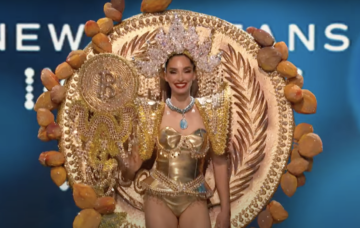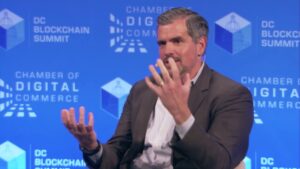
Peter Thiel, the co-founder of PayPal and Palantir said at a conference in Miami that he may have met bitcoin’s inventor, Satoshi Nakamoto, on a beach in the Caribbean island of Anguilla in February 2000.
That’s when he met the founders of E-Gold, a failed attempt to create a gold backed digital currency through a company that was shut down by the US government in 2007 for “illegal money transmitting” with its founders indicted.
“My sort of theory on Satoshi’s identity was that Satoshi was on that beach in Anguilla,” Thiel said, further adding:
“I met [the E-Gold founders] on the beach in Anguilla in February of 2000. We were beginning the revolution against the central banks on the beach in Anguilla. We were going to make PayPal interoperable with E-Gold and blow up all the central banks.”
He suggests Nakamoto may have been one of the 200 attendants in that gathering, a gathering that was actually a conference sponsored in part by E-Gold as well as others.
“Bitcoin was the answer to E-Gold, and Satoshi learned that you had to be anonymous and you had to not have a company,” Thiel said. “Even a company, even a corporate form was too governmentally linked.”
The February 20-24th in 2000 conference was the fourth on Financial Cryptography. This international gathering is described on the first conference, February 24–28, 1997, as a gathering of “cryptographers, security experts, computer hackers, lawyers, bankers and journalists.”
In attendance for the first conference as part of the program committee were individuals from the Federal Reserve Bank of New York, Citibank and AT&T Laboratories as well as others. Suggesting that rather than some fringe underground gathering of revolutionaries, this was a business conference of respectables.
It was sponsored by The Journal of Internet Banking and Commerce, with a number of papers presented addressing cryptographic needs for digital banking.
At that first gathering there were also papers like “Electronic cash-technology will denationalise money” and “Efficient electronic cash with restricted privacy.”
The second one is algorithm heavy, while the first is more a somewhat boring essay on how private enterprise might issue money, an essay that gets a lot of it wrong.
The fourth book that came out of these conferences, the one attended by Thiel, is very technical with a lot of maths. This was thus a gathering of experts in a niche field at the dawn of the birth of digital commerce, way back when internet banking was just coming into existance.
There are many names, mostly cryptographers, with little to suggest who exactly might be Satoshi Nakamoto as any one of them could be, or maybe a group of them, or maybe someone actually called Satoshi, Satoshi Obana, or maybe none of them.
Thiel therefore has said nothing more than Nakamoto was/is an expert in this field and such experts tend to meet in conferences so he probably was in one of them.
But he does bring attention to a somewhat forgotten history, which can counteract a tendency in general to see Halloween 2008 as the beginning of digital money, rather than just one step in a long march of technological progress.
Nakamoto too, like all inventors, stands on the shoulders of giants and some say he invented nothing except how to put together what had been invented by others.
These two volumes of some 400 pages each might go some way towards supporting that suggestion, but the genius of Nakamoto was to use human nature and incentives as an algorithmic input towards a network design that solves the double spending problem.
It would be easy to say he took a practical approach, but it would be more correct to say he utilized a wider wholistic thinking in deciding what to include within technical ‘purity’ in a blending of sorts of humans and code, and in this case it happened to work.
This leap has turned out to be so elegant that on the one hand it is an almost unnoticeable mere incremental improvement within a very technical field, and on the other hand encourages such bravado as Thiel wanting to “blow up the central banks.”
That confusion tends to simplify opinion on cryptos with some seeing it as just the latest in the march of advancement, while others like to ascribe moral (for lack of a better word) dimensions.
There is no morality on a tool itself, however, only on how it is used. Until the first view prevails therefore, it may well be Nakamoto is kept as a myth, for the ‘figure’ has reached the stage where who he is has become a matter not just for the person himself to reveal, but also for us all collectively to accept it.
In such a way, an alchemy of sorts is performed where Nakamoto the myth contains in his story all the moral dimensions, freeing the network and the invention from it, while at the same time the lack of a person denies any such attribution.
Like a Greek tale, this too perhaps allows us to deconstruct simplistic opinion, to peel the many layers, so as to ultimately reveal the objective base for collective understanding.
A collective that is probably not inclined to blow up central banks. They had the opportunity to do so at the Swiss Referendum on Sovereign Money in 2018 on which this paper ultimately came against because it was too sudden of a change in a very complex financial system that good or bad, does still afford us to enjoy this great peace.
What Nakamoto may have learned therefore, or we are learning, is not that a lack of a company but that a different money in substance is not existentially threatening in a sudden way.
Choice is a lot better, competition, a continuous public vote that tracks minute change in factors to, at each moment, voice what they prefer.
We don’t need to blow up anything. In fact, we stand in front of the peasants who rely upon us to succeed and if they end up blowing up anything, it would be because we failed, not because we succeeded.
Out task is to advance the capabilities of man, something that necessarily produces change, and if some don’t adapt to change, they will lose, but not because we want them to, but because that’s the process of improvement.
Some won’t be able to adapt, but that is some institutions or institutional functions like issuing stocks. The individuals within such institutions, especially the younger ones, do have the full and free choice.
That’s the revolution. Bringing back competition to finance, making it adapt, making it fit for this digital 21st century, and in the process increasing the efficiency of the management of our resources to the point we can begin the age of space exploration.
In that prism, Nakamoto is less a myth than just one of the pioneers of the digital age that stands alongside many, many others.
It’s about time he is viewed as such. It’s about time the technical achievements, that science in the fine tradition of the enlightenment, are put front and center, and it may be time the myth is turned into a people’s award, a celebration of that very technical achievement in our time in computer science.
Otherwise said, it may be time to get rid of the emotive subjective, and it may be time to finally come out of the shell and see the objective unquestionable extension of our financial capabilities that are no longer controversial in their technical foundations and often are quite cool as we can now do what we could not thanks to the impeccable intellect of man.
Source: https://www.trustnodes.com/2021/10/23/did-peter-thiel-meet-satoshi-nakamoto
- algorithm
- All
- AT&T
- Bank
- Banking
- Banks
- business
- Cash
- Central Banks
- change
- Co-founder
- code
- coming
- Commerce
- company
- competition
- computer science
- Conference
- conferences
- confusion
- cryptography
- Currency
- Design
- DID
- digital
- digital banking
- digital commerce
- digital currency
- Digital Money
- efficiency
- Enterprise
- experts
- exploration
- Federal
- federal reserve
- Federal Reserve Bank
- Finally
- finance
- financial
- fine
- First
- fit
- form
- founders
- Free
- full
- General
- Gold
- good
- Government
- great
- Group
- hackers
- history
- How
- How To
- HTTPS
- Humans
- Identity
- Institutional
- institutions
- International
- Internet
- IT
- Journalists
- Justice
- latest
- Lawyers
- learned
- learning
- Long
- Making
- man
- management
- March
- money
- names
- network
- New York
- Opinion
- Opportunity
- Other
- Paper
- PayPal
- privacy
- private
- Program
- public
- reserve bank
- Resources
- Satoshi
- Satoshi Nakamoto
- Science
- security
- Shell
- So
- Space
- Spending
- Sponsored
- Stage
- Stocks
- substance
- Swiss
- system
- Technical
- Thinking
- time
- us
- us government
- View
- Voice
- Vote
- WHO
- within
- Work












